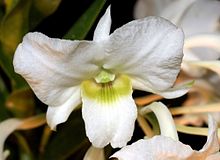Dendrobieae
| Dendrobieae | |
|---|---|

| |
| Dendrobium dearei | |
| Scientific classification | |
| Kingdom: | Plantae |
| Clade: | Tracheophytes |
| Clade: | Angiosperms |
| Clade: | Monocots |
| Order: | Asparagales |
| Family: | Orchidaceae |
| Subfamily: | Epidendroideae |
| Tribe: | Dendrobieae Lindl. ex Endl. |
| Genera | |
Dendrobieae is a tribe in the subfamily Epidendroideae, in the family Orchidaceae.[1]
The Dendrobieae are mostly tropical, epiphytic orchids which contain pseudobulbs.
A few species in this tribe, such as Dendrobium and Bulbophyllum, are strongly favored by orchid growers.
Features[]
Dendrobieae are mostly small, epiphytic orchids. The roots are covered by velamen. There are usually pseudobulbs present, with leaves at the top; sometimes the species lacks pseudobulbs and the leaves are spread across the stem or the plant is leafless.
The flowers are terminal or axillary and spread across the stalk. The gynostemium is firm, with a clear foot. The anther is bent. The two or four pollinia are naked, they contain no viscidium, just like the Malaxideae.
Distribution[]
Dendrobieae have a pantropical distribution.
Taxonomy[]
Taxonomy according to Dressler, Cameron and van den Berg[]
The taxonomy of Dendrobieae is still under discussion. The group has been described with the composition below by Dressler (1993),[2] but appears to be a polyphyletic group. This was investigated by et al. (1999)[3] and van den Berg et al. (2000).[4] However, they moved the genus Pseuderia to the tribe Podochileae. As a result, the tribe contained two subtribes, 27 genera and about 3,000 species.
Dendrobieae ' s phylogenetics can be seen below:
| Epidendroideae |
| |||||||||||||||||||||||||||||||||||||||||||||||||||||||||||||||||||||
- Subtribe: Bulbophyllinae
- Genera:
- Acrochaene - Bulbophyllum - Chaseella - Cirrhopetalum - Codonosiphon - Drymoda - Epicrianthes - Ferruminaria - Hapalochilus - Ione - Mastigion - Monomeria - Monosepalum - Osyricera - Pedilochilus - Rhytionanthos - Saccoglossum - Sunipia - Synarmosepalum - Tapeinoglossum - Trias - Vesicisepalum
- Genera:
Taxonomy according to Clements[]
In various studies in 2003[5] and 2006[6] based on DNA analysis, Clements called for a review of Dendrobieae to be placed in the more monophyletic groups. Thus Bulbophyllinae was positioned earlier while Podochileae in its original position.
He placed the genus Epigeneium in a separate monophyletic subtribe, , after Dendrobieae. The genus Dendrobium is split further: The species of the section Oxystophyllum were placed under Podochileae, the Australasian Dendrobium-species were split into a new set of genera in the subtribe.
The Dendrobiinae subtribe then contained the genus Dendrobium which includes the Asiatic species of the former giant genus, totalling over 450 species, and several genera separated from it.
Based on his Dendrobium research, it was found that in the future, even more monphyletic groups could be identified in the future as separate genera.
The pedigree chart of Dendrobieae can be found below:
| Epidendroideae |
| ||||||||||||||||||||||||||||||
- Subtribe: Dendrobiinae s.s.
- Genera:
- Anisopetala - Aporum - - - Coelandria - Dendrobium s.s. - Distichorchis - Eurycaulis - Pedilonum
- Genera:
- Subtribe:
- Genera:
- Subtribe:
- Genera:
- Abaxianthus - Australorchis - Bouletia - Cadetia - Cannaeorchis - Cepobaculum - Ceratobium - Davejonesia - - Dichopus - Diplocaulobium - Dockrillia - Durabaculum - Eleutheroglossum - Eriopexis - Euphlebium - Exochanthus - Flickingeria - Grastidium - Herpetophytum - - Kinetochilus - Leioanthum - Microphytanthe - Monanthos - Sarcocadetia - Sayeria - Stilbophyllum - Tetrabaculum - Tetrodon - Thelychiton - Trachyrhizum - Tropilis - Vappodes - Winika
- Genera:
References[]
- ^ Lindleyana: The Scientific Journal of the American Orchid Society. The Society. 1999. Retrieved 30 April 2013.
- ^ Robert L. Dressler, 1993: Phylogeny and Classification of the Orchid Family. S. 105ff. Cambridge University Press, ISBN 0-521-45058-6
- ^ K.M. Cameron, M.W. Chase, W.M. Whitten, P.J. Kores, D.C. Jarrell, V.A. Albert, T. Yukawa, H.G. Hills & D.H. Goldman, 1999: A phylogenetic analysis of the Orchidaceae: evidence from rbcL nucleotide sequences
- ^ C. van den Berg, D.H. Goldman, J.V. Freudenstein, A.M. Pridgeon, K.M. Cameron & M.W. Chase, 2005: An overview of the phylogenetic relationships within Epidendroideae inferred from multiple DNA regions and recircumscription of Epidendreae and Arethuseae (Orchidaceae)(abstract)
- ^ [http://www.rbgsyd.nsw.gov.au/__data/assets/pdf_file/0003/72723/Tel10Cle247.pdf M.A. Clements (2003): Molecular phylogenetic systematics in the Dendrobiinae (Orchidaceae), with emphasis on Dendrobium section Pedilonum. Telopea 10: 247 - 298
- ^ M.A. Clements, 2006: Molecular phylogenetic systematics in Dendrobieae (Orchidaceae). Aliso 22: 465 - 480
Further reading[]
- Lindley, J. (1837) Genera Plantarum 190.
- Dressler, R.L. (1993) Phylogeny And Classification Of The Orchid Family, Cambridge, Cambridge University Press.
- Chase, M.W., Cameron, K.M., Barrett, R.L. & Freudenstein, J.V. (2003). DNA data and Orchidaceae systematics: a new phylogenetic classification. pp. 69–89, in Dixon, K. M., S. P. Kell, R. L. Barrett, and P. J. Cribb [eds]. Orchid conservation. Natural History Publications, Kota Kinabalu, Sabah, Malaysia.
- Chase, M.W. (2005) Classification of Orchidaceae in the Age of DNA data, Curtis's Botanical Magazine, Volume 22 (1): 2–7.
| Wikispecies has information related to Dendrobieae. |
- Dendrobieae
- Epidendroideae tribes
- Pantropical flora